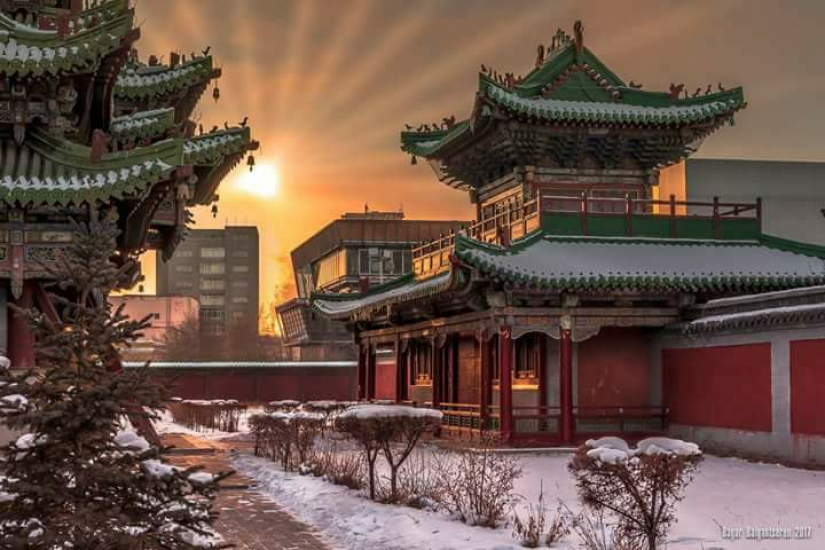During the Qing Dynasty period, the names of certain significant monasteries and palaces that met royal standards were given by Emperor’s decree. There are a number of Emperor’s decrees for bestowing names on Mongolian monasteries in the Mongolian National Central Archive.
There is an interesting construction called ‘Shield Wall’ in front of the entire palace or monastery complex. Only a few complexes were permitted by the Emperor decree, again, to erect such construction because it indicates not only royal rank but also emperor’s dignity and status.
That is to say, this construction serves as a special emblem or identity card for royal ranking, power and dignity as equal as the Emperor, himself, in manifold ways. According to archive documents, special notice board-like constructions, warning all visitors to leave their horses and carriages when entering the boundary, were erected on the sides of the Shield Walls.
Such walls were only erected in front of significant monasteries throughout the entire Qing Dynasty and held under the Qing Emperor’s protection during the 18th and 20th centuries. It is said that most of the original shield walls in China were destroyed after the fall of the Qing Dynasty and during the Cultural Revolution era, and hence, present day ones have been reconstructed as tourist attractions.
However, this should be confirmed with Chinese sources. There are only three existing monastery complexes with such walls in modern day Mongolia. Those are:

Amarbayasgalant Monastery
which was constructed in between 1727 and 1736 by Qing Emperor’s decree for Undur Gegeen Zanabazar, who was spiritual mentor to two Qing Emperors
Bogd Khaan Palace Museum
in modern day Ulaanbaatar which was constructed in between 1893-1903 as the monastery and residency for the Eighth Bogd Jebzundampa and last king of Mongolia
Choijin Lama Temple Museum
Ulaanbaatar, which was constructed in between 1904-1908 for the sake of the State Oracle Lama’s trance activities.
The shield wall of Amarbayasgalant monastery
The shield wall of Amarbayasgalant monastery is quite distinct from the other two (the ones in modern day Ulaanbaatar are more or less similar). It is sixteen meters wide while its width is 0.95 metres.
Depicted on the wall’s front centre is a circular pattern, in which there are four blossomed flowers in a porcelain jar; above these are a flying bird and four flowers those are not yet in bloom; below the jar there are two flowers and leaves; all of them are beautifully embossed and colourfully glazed.
Four blossomed flowers symbolize four seasons while the porcelain jar symbolizes peace and tranquility. That is to say, all beings are living in peace and tranquility throughout the four seasons.
Furthermore, blooming flowers symbolize the present time while flowers not yet in bloom symbolize the unbroken lineage of future generations. On the back there are two circling dragons which depict method and wisdom in the center.

The shield wall of the Bogd Khaan Palace museum
The Bogd Khaan Palace Museum shield wall is depicted by five dragons with five nails, which indicate the status of a king, soaring above the milk ocean and Mount Sumeru at the centre of the back side. Unfortunately, its other significant depictions have not been preserved up to our era.
Its decorations might be more or less the same as the Choijin Lama Temple shield wall except for the number of dragon claws.
Shield Wall of the Choijin Lama Temple museum
The Choijin Lama Temple Museum shield wall is very peculiar and specific in terms of its decorative arts and beauty. It is also well preserved up to our era. It rises nine metres high and is sixteen metres wide in front of the temple complex, at the far southern end.
Depicted on the wall’s front centre panel is the mythical bird Garuda together with two lions. The front of the two flanking walls features the eight immortal protectors who are most popular in the culture of oriental countries. On the back there are five dragons with four nails at the centre, and depictions of Bodhisattvas, the Old White Man and the famous Six Beings of Longevity at the two sides.
The entire wall is richly decorated with eight auspicious signs of Buddhism, dragons and lotus flower patterns. It is most likely that it had a makara head as protector from waters, four directions guarding animals, etc., on its roofing.
Generally, both shield walls of Bogd Khaan Palace and Choijin Lama Temple were originally ornamented with all the complete sets of symbols for Buddhist monastery constructions.
The Shield Wall is dedicated to guarding the monastery against all dangers, obstacles and evil energies entering through the main gate. Moreover, it served as an emblem depicting royal ranking in practical life as mentioned above.
Khatanbaatar Choi A Researcher, the Institute of Chinggis Khaan Heritage and Culture
source: mongoliatravel.guide

